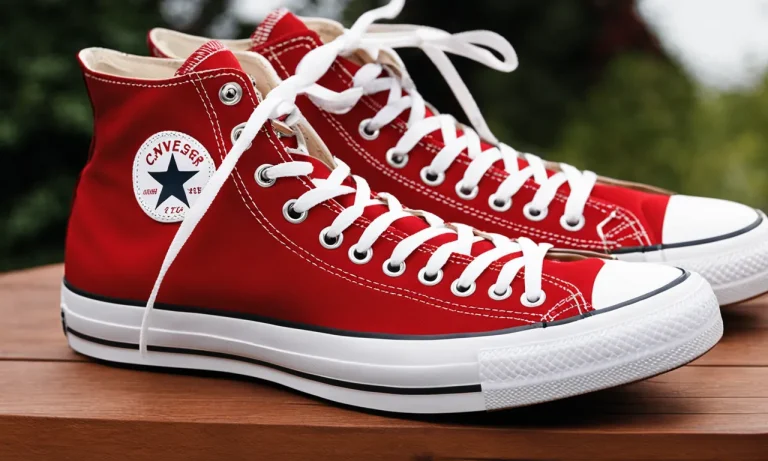Figuring out your proper shoe size is an important step in finding comfortable, well-fitting footwear. But with different sizing systems used around the world, it can be tricky to determine your UK shoe size if you’re visiting from elsewhere.
If you’re short on time, here’s a quick answer: Your UK shoe size is typically 1-2 sizes smaller than your US size. So if you’re a US size 9, you’re likely a UK size 7-8.
In this comprehensive guide, we’ll cover everything you need to know about UK shoe sizing. You’ll learn about the different UK sizing scales, how to measure your feet, factors that affect your size, size conversion charts, and tips for finding the right fit.
Understanding UK Shoe Sizing Scales
UK Adult Sizes
When it comes to buying shoes in the UK, understanding the sizing scales is essential. UK adult shoe sizes follow a different system compared to other countries such as the US or Europe. In the UK, shoe sizes for adults are based on the length of the foot in inches.
So, if you’re wondering what your shoe size is in the UK, you’ll need to measure your foot in inches to find the right fit.
UK adult shoe sizes typically range from 3 to 13 for women and 6 to 15 for men. However, it is important to note that shoe sizes can vary slightly between different shoe brands and styles. Therefore, it’s always a good idea to try on shoes before making a purchase or refer to the specific size chart provided by the brand.
If you’re unsure about your UK shoe size, many shoe stores offer measurement services to help you find the perfect fit. You can also find online resources and conversion charts that can assist you in determining your UK shoe size based on your foot measurements.
UK Children’s Sizes
Just like with adult sizes, UK shoe sizes for children also follow a different scale compared to other countries. The UK children’s shoe sizing system takes into account both the length and width of the foot. This ensures a more accurate fit for growing feet.
UK children’s shoe sizes typically range from 0 to 13.5 for infants and from 1 to 6 for older children. Similar to adult sizes, it’s important to consider that shoe sizes can vary between different brands.
It’s always recommended to measure your child’s feet and refer to the specific size chart provided by the brand or store to ensure the best fit.
When shopping for children’s shoes, it’s also important to allow for some room to accommodate growth. Children’s feet can grow quickly, so selecting shoes that provide a little extra space is a wise choice.
This will ensure that the shoes will last longer and allow room for the feet to grow comfortably.
What the Size Numbers Mean
The size numbers on UK shoe labels represent the length of the foot in inches. For example, if you see a shoe labeled as “UK size 6,” it means that the length of the shoe is approximately 6 inches.
However, it’s important to note that different shoe brands may have slight variations in their sizing. Some brands may use half sizes or offer wider or narrower options to accommodate different foot shapes.
Therefore, it’s always a good idea to try on shoes or refer to the specific size chart provided by the brand to ensure the best fit.
For more information on UK shoe sizing and conversion charts, you can visit reputable websites such as www.shoezone.com or www.clarks.co.uk. These websites provide comprehensive guides and resources to help you find the right shoe size in the UK.
Measuring Your Feet for Proper Sizing
Getting the right shoe size is crucial for comfort and preventing foot problems. Whether you’re shopping for shoes online or in-store, knowing your shoe size is essential. Here are a few methods you can use to measure your feet accurately:
Using a Brannock Device
The Brannock Device is a widely used tool in shoe stores for measuring foot size. It provides precise measurements for both length and width. When using a Brannock Device, simply place your foot on the device and adjust the sliders until they fit snugly against your foot.
The measurements will be displayed on the device, helping you determine your shoe size.
DIY Measuring at Home
If you don’t have access to a Brannock Device, you can measure your feet at home using a ruler or tape measure. Start by placing your foot on a piece of paper and trace its outline. Then, measure the length from the heel to the longest toe and the width at the widest point.
Use these measurements to determine your shoe size using an online shoe size chart or consult a size conversion chart for the UK. Keep in mind that different brands may have slightly different sizing, so it’s always a good idea to check their specific size guide before making a purchase.
Getting Professionally Fitted
If you’re unsure about measuring your feet accurately, it’s best to seek professional help. Many shoe stores offer professional fitting services where trained staff can measure your feet and recommend the right shoe size for you.
They take into account factors such as arch type, foot width, and any specific foot conditions you may have. Getting professionally fitted ensures that you find the perfect fit and reduces the chances of discomfort or foot problems.
Remember, shoe size can vary depending on the brand and shoe type, so it’s essential to measure your feet regularly and try on shoes before making a purchase. Properly fitting shoes not only provide comfort but also contribute to the overall health and well-being of your feet.
Factors That Can Affect Your Shoe Size
When it comes to finding the right shoe size, there are several factors that can affect the fit and comfort of your shoes. Understanding these factors can help you make informed decisions when purchasing footwear. Here are some key factors to consider:
Foot Length and Width
The length and width of your feet play a vital role in determining your shoe size. It’s important to measure both feet accurately, as they may not be the same size. Your shoe size is typically based on the length of your foot, but the width is equally important for a comfortable fit.
If you have wide feet, you may need to look for shoes with a wider width to ensure a proper fit.
Time of Day
Believe it or not, your shoe size can actually vary throughout the day. Feet tend to swell as the day goes on, especially if you are on your feet for extended periods of time. Therefore, it is recommended to measure your feet later in the day when they are at their largest.
This will help ensure that you choose the right shoe size that accommodates the natural swelling of your feet.
Sock Thickness
The thickness of the socks you plan to wear with your shoes can also affect the fit. If you usually wear thicker socks, it is advisable to try on shoes with those socks to ensure a comfortable fit. On the other hand, if you prefer thinner socks, you may need to adjust your shoe size accordingly.
Keep in mind that different shoe styles may also require different sock thicknesses for optimal comfort.
Foot Conditions
Some foot conditions, such as bunions or hammertoes, can impact the size and shape of your feet. If you have any pre-existing foot conditions, it is essential to consider them when determining your shoe size.
Certain shoe styles or brands may be more accommodating for specific foot conditions, so it’s worth doing some research or seeking advice from a podiatrist to find the best options for your needs.
Remember, finding the right shoe size is crucial for your comfort and foot health. By taking into account factors such as foot length and width, the time of day, sock thickness, and any foot conditions, you can ensure a proper fit and enjoy your shoes to the fullest.
UK to US Shoe Size Conversion Charts
Women’s Sizes
When it comes to converting UK shoe sizes to US shoe sizes for women, it’s important to have a reliable conversion chart. Fortunately, there are several reputable websites that provide accurate and up-to-date information on this topic.
One such website is shoesize.com, which offers a comprehensive UK to US shoe size conversion chart specifically for women. This chart takes into account the differences in sizing systems between the two countries and provides a simple and easy-to-use reference for finding your correct shoe size.
It’s worth noting that UK and US shoe sizes are not the same. In general, UK sizes tend to be smaller than their US counterparts. For example, if you wear a UK size 6, you would typically need to go up half a size to a US 6.5.
Men’s Sizes
For men looking to convert their UK shoe size to a US size, there are also reliable conversion charts available online. One trusted source is shoesizer.co.uk, which provides a detailed conversion table specifically for men’s shoe sizes.
Similar to women’s sizes, it’s important to note that UK and US men’s shoe sizes differ. In general, UK sizes tend to be smaller than US sizes. For example, if you wear a UK size 9, you would typically need to go up half a size to a US 9.5.
Children’s Sizes
Converting children’s shoe sizes from UK to US can be a bit trickier, as sizing systems can vary between brands and age ranges. However, there are still resources available to help you find the right conversion.
One useful website for children’s shoe size conversion is shoezone.com. They provide a handy chart that takes into account both UK and US sizes for children’s shoes, making it easier for parents to find the right fit for their little ones.
It’s important to keep in mind that children’s feet can grow quickly, so it’s always a good idea to measure their feet regularly. This will ensure that they are wearing the correct size and avoid any discomfort or potential foot problems.
Remember, these conversion charts are meant to serve as a guide, and it’s always best to try on shoes before making a purchase. Different brands may have slight variations in sizing, so it’s important to take that into consideration as well.
Tips for Finding the Perfect Fit
Try Shoes On in the Afternoon
When it comes to finding the right shoe size in the UK, timing is everything. Your feet can swell throughout the day, so it’s best to try shoes on in the afternoon. This will give you a more accurate measurement and ensure that your shoes fit comfortably all day long.
Wear Socks You’ll Normally Wear
Another important tip is to wear the socks that you would normally wear with the shoes. Different types of socks can affect the fit, so it’s essential to have the right ones on when trying on shoes. This way, you can ensure that there is enough room for your feet without being too tight or too loose.
Stand Up and Walk Around
Don’t just stand still when trying on shoes; walk around the store or the room. This will give you a better sense of how the shoes feel when in motion. Pay attention to any areas of discomfort or tightness.
Remember, you want your shoes to be comfortable both when standing still and when walking around.
Pay Attention to Width
Finding the right shoe size isn’t just about the length; width plays a crucial role as well. Some brands offer different width options, so be sure to try on shoes that match your foot width. Shoes that are too narrow can cause discomfort, while shoes that are too wide may not provide enough support.
Break Shoes In Slowly
Once you find the perfect fit, it’s important to break your new shoes in slowly. Wearing them for a few hours at a time and gradually increasing the duration will help the shoes mold to your feet and prevent any potential discomfort.
This will ensure that your shoes become your perfect fit in no time!
Conclusion
Knowing your accurate UK shoe size is the first step to finding comfortable footwear during your travels. With an understanding of the sizing system, proper measurement techniques, conversion charts, and fit tips, you can determine your size and shop confidently, avoiding the hassle of returns and exchanges.
Just remember that sizing differs across brands, so always try shoes on before purchasing. Happy shoe shopping on your UK adventure!






